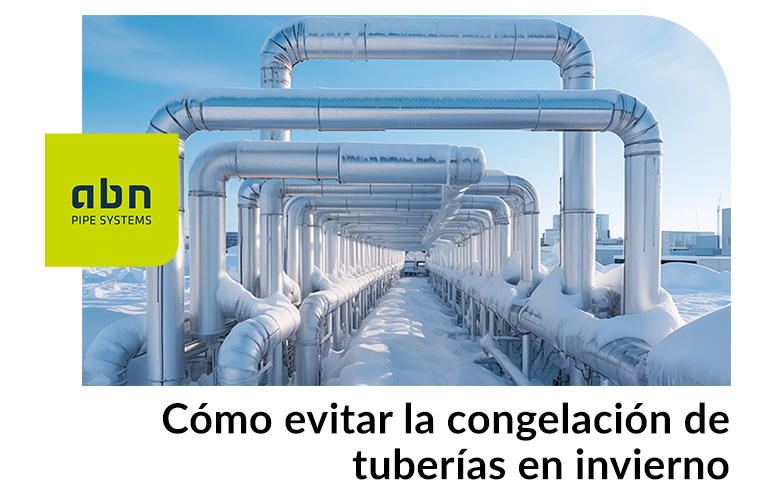Las temperaturas invernales pueden representar un desafío para el buen estado de las tuberías, especialmente aquellas ubicadas en el exterior. Desde la interrupción del suministro de agua hasta la rotura de los tubos, las consecuencias de la congelación de las tuberías traen consigo problemas de servicio y en ocasiones, también de costes.
Las tuberías exteriores son particularmente propensas a este riesgo debido a la exposición directa al frío. Comprender los riesgos es el primer paso para implementar medidas preventivas efectivas.
Importancia del aislamiento en tuberías exteriores
Las tuberías de polipropileno son ampliamente reconocidas por su durabilidad y resistencia. Sin embargo, incluso los materiales más robustos pueden enfrentar desafíos significativos cuando se trata de las bajas temperaturas invernales. Es en este contexto, en el que la importancia del aislamiento en tuberías exteriores cobra un papel crucial para el mantenimiento y la protección de estos sistemas.
- Aumenta la vida útil de la tubería: El aislamiento actúa como un escudo térmico, evitando que las tuberías entren en contacto directo con el frío extremo y manteniendo su integridad estructural a lo largo de las estaciones invernales.
- Previene la congelación y sus consecuencias: El aislamiento, al mantener una temperatura más constante alrededor de las tuberías, actúa como un escudo protector contra esta amenaza, reduciendo drásticamente el riesgo de congelación y, por ende, los costosos daños asociados.
- Garantiza un rendimiento óptimo con el paso del tiempo: Al proteger las tuberías de las fluctuaciones extremas de temperatura, también contribuye a mantener un flujo de agua constante, evitando bloqueos y pérdidas de presión que podrían afectar negativamente el rendimiento general del sistema.
- Ahorro y sostenibilidad: Al prevenir la congelación y las consiguientes fugas, se reducen los gastos de reparación y se evitan pérdidas innecesarias de agua, contribuyendo así a la sostenibilidad del recurso hídrico y al ahorro financiero a largo plazo.
Riesgos de congelación en tuberías exteriores
La congelación no solo crea presión interna en las tuberías, sino que también puede dar lugar a daños costosos, afectando incluso a la funcionalidad de todo el sistema hidráulico. Es en esta temporada que se vuelve evidente la necesidad de un buen mantenimiento preventivo.
Es esencial estar alerta a los signos de tuberías congeladas. Si se escuchan sonidos inusuales en la instalación de agua o se evidencia un flujo de agua irregular a través de los grifos, es probable que una parte de la tubería esté congelada. Abordar estos signos tempranos puede evitar daños mayores y costosas reparaciones.
Las tres principales causas de una tubería congelada son:
- Bajada brusca de temperatura: Cuando las temperaturas descienden rápidamente, el agua dentro de las tuberías puede congelarse, generando una presión interna considerable. Este aumento de presión puede resultar en la ruptura de las tuberías, lo que, a su vez, puede llevar a inundaciones y costosas reparaciones.
- Aislamiento deficiente: Los orificios por donde estas atraviesan paredes o suelos son puntos críticos que permiten que el aire frío penetre y afecte la temperatura interna de las tuberías. Sin el aislamiento adecuado, las tuberías quedan vulnerables a la congelación, aumentando exponencialmente el riesgo de daños.
- Termostato programado demasiado bajo: Si la temperatura ambiente se mantiene por debajo del punto de congelación, el agua en las tuberías puede solidificarse. Ajustar el termostato a una temperatura más alta, especialmente durante las noches más frías, ayuda a mantener las tuberías a salvo de las temperaturas extremas.
Recomendaciones para evitar que se congelen las tuberías
Aunque la mayor parte de los elementos que canalizan el agua están fuera de nuestro alcance, existen algunos hábitos que pueden prevenir las tuberías congeladas.
- Evitar el estancamiento del agua y cerrar la corriente en condiciones extremas. Cuando las temperaturas caen drásticamente, cerrar la llave de paso y vaciar las tuberías es esencial. Este paso impide que el agua se acumule en las tuberías, reduciendo así el riesgo de congelación y rupturas.
- Sellar huecos alrededor de orificios de penetración. Los orificios por donde las tuberías atraviesan paredes o suelos son puntos críticos. Se puede utilizar masilla o aislante de espuma para sellar estos huecos, tanto en el interior como en el exterior, evitando la entrada de aire frío y manteniendo el calor dentro.
- Aislar adecuadamente las áreas desprotegidas. Las tuberías en sótanos, áticos u otras áreas desprotegidas pueden necesitar aislamiento adicional. La goma espuma o las fundas de fibra de vidrio ayudan a reducir las posibilidades de congelación y garantizan un entorno térmico adecuado.
- Mantener la calefacción en periodos de ausencia prolongada. Durante ausencias prolongadas, mantener la calefacción encendida a un nivel moderado es esencial. Este calor residual es suficiente para prevenir la congelación de las tuberías y los consiguientes daños.
- Instalación de tuberías resistentes a temperaturas extremas o preaisladas. Optar por tuberías diseñadas específicamente para resistir condiciones climáticas adversas o preaisladas, asegura un rendimiento óptimo.
El aislamiento efectivo de las tuberías es esencial para proteger las construcciones de los estragos del frío invernal. Implementar las recomendaciones, y realizar una elección de producto acertada, no solo preserva la integridad de las tuberías, sino que también proporciona tranquilidad y ahorra costes en mantenimiento y reparación.
